
Italian Bread
Once you make homemade bread, you’ll never go back to buying bread. This overnight Italian bread is my new favorite. The crust is crispy and chewy but the crumb is so tender and fluffy. It’s perfect as toast, for sandwiches, grilled cheeses, dipping in soups or dips, etc.
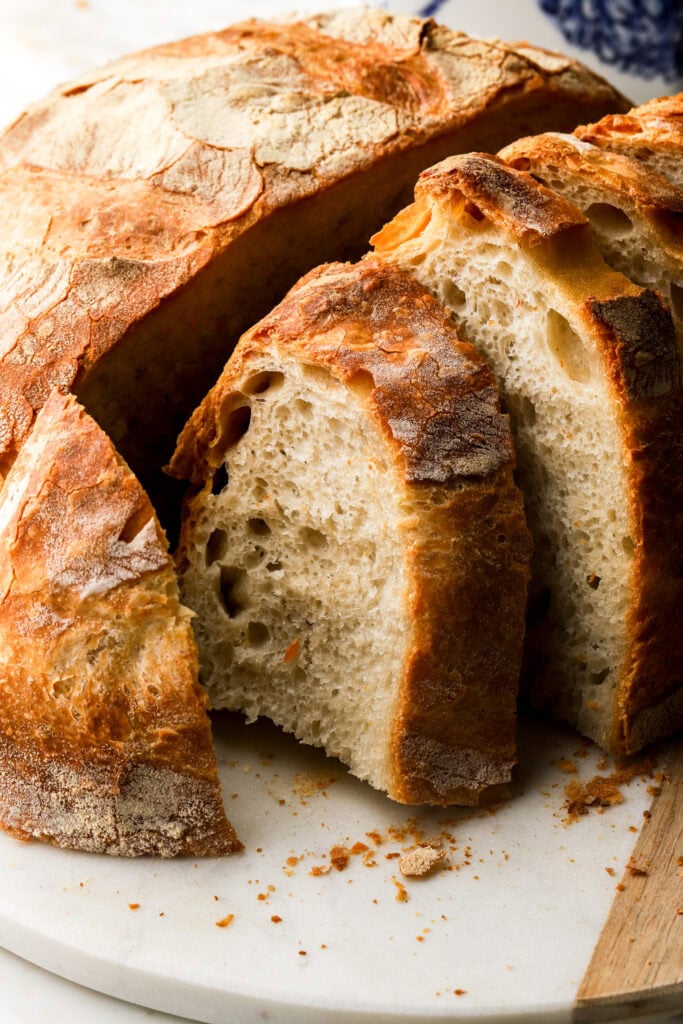
Why You’ll love this Italian bread
- I mean I don’t know about you, but if I have one weakness, it’s homemade bread.
- This recipe only uses like 5 simple ingredients, which you most likely already have.
- Very minimal hands on time and can be refrigerated to prolong rising.
I have a website where I post a ton of dessert recipes but the truth is, bread is my weakness. I love bread. I’ve been making bread on and off for the last 6 years but really haven’t posted my own recipe until that’s all my kids wanted to eat so my first bread recipe on here was my Sandwich bread. But you better believe I’ll be posting more!
I also have a chocolate croissant recipe but skip the chocolate and you have a fabulous homemade croissant.

What is Italian Bread?
There are sooooo many types of breads and so many different recipes for each type of bread.
Artisan bread is traditionally lean, meaning it’s just made of just flour, salt, yeast and water. Brioche dough is very enriched, meaning we’ve added sugar, butter, eggs and/or milk. This Italian bread is only slightly enriched, even less than my sandwich bread – I add just a tiny bit of fat like butter or olive oil.
Even Italian bread has so many different types like focaccia, ciabatta, etc. This bread is inspired by a bread I had at an Italian restaurant that was to die for. The crust is crispy and chewy but the crumb is so tender and fluffy.
It’s a no-knead bread and it still holds a great shape thanks to the stretch and fold method and of course, the long overnight rise time.

How To Make Italian Bread
Making bread sounds more intimidating than it is. It’s a very simple process, it’s just more of a timely matter. This is a no-knead bread but giving it time to rise overnight is essential for the structure and flavor.
- Flour: I use both all-purpose flour and bread flour for this recipe and both work totally fine. I like bread flour best because the higher gluten content gives it a better structure and chew.
- I highly recommend weighing your flour with a digital scale.
- Water: I use warm water but it really doesn’t matter here. I don’t even “activate” my active dry yeast so as long as the water isn’t very hot, the temperature doesn’t really matter.
- Yeast: this recipe works with both active dry yeast and instant yeast. I follow the same process for both, I don’t even activate my active dry yeast, I just add it in with all of the ingredients and let it rest overnight.
- You’ll notice that for 5 cups (600g) of flour, I only have ½ tsp of yeast. That’s because when you let something rise for a long time, you don’t need nearly as much. The more you add, the quicker it will rise but it will lack structure and flavor.
- Fat: I initially made this bread without fat, just water, salt, yeast and flour. However, after I tried that bread at the Italian restaurant, the crumb was so tender I knew they had to have some fat added to the dough. I prefer butter, but avocado or olive oil work just as well. The photos are made with olive oil so you can see the inside is a bit spongier and darker in color than it would be with butter.
- Mixing: I simply just mix everything together in a bowl until it comes together. The dough is VERY sticky and shaggy so I use a stand mixer with a hook attachment because that’s just easier but you can use a spatula, a danish dough whisk or your hand.
- After the dough is mixed, I do two series of stretches and folds to strengthen the gluten.
- Proofing: Dough proofs best at room temperature or slightly warmer. The colder the room, the slower the rise will be. Since this is rising overnight, I like to keep it at room temperature, preferably below 75F (24C).
What kind of yeast to use for overnight bread
The recipe is written using active dry yeast because that’s what I had on hand but if you want to substitute it for instant yeast, just follow the same instructions.
Unlike instant yeast, active dry yeast usually needs to be activated by combining the warm water with the yeast in a large cup, mixing it and letting it rest for 10 minutes. The water should develop a thick layer of foam on top. I skipped this. I saw someone use active dry yeast without activating it first so I tried it and it worked. I believe activating it would make it work quicker in a recipe that is used right away but because this is rising overnight, I just mixed everything in a bowl together at the same time, like you would for instant yeast.

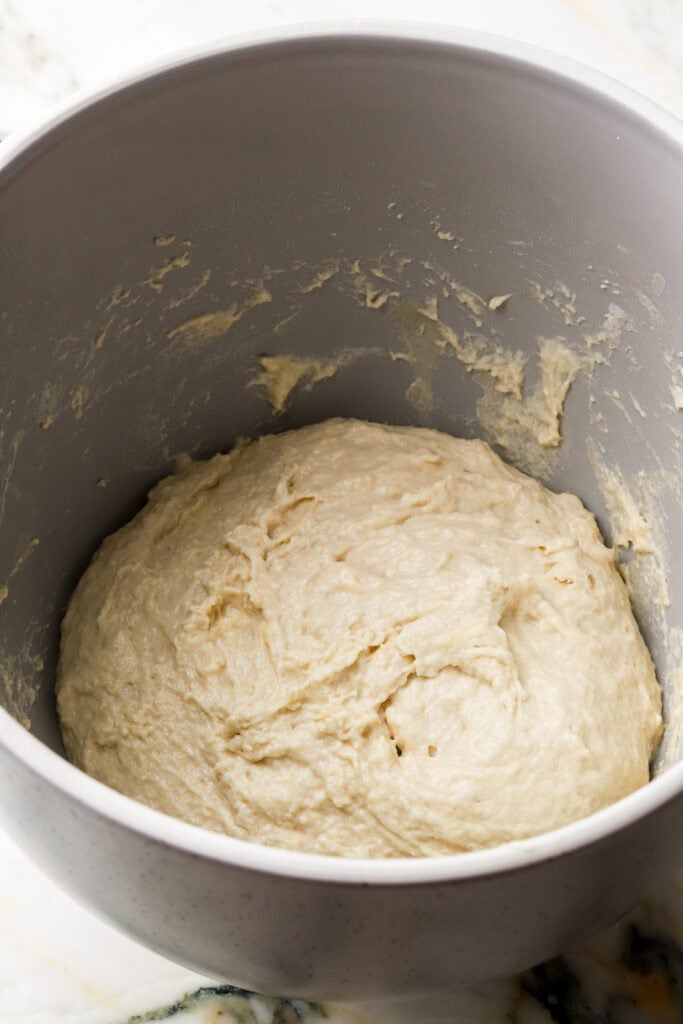
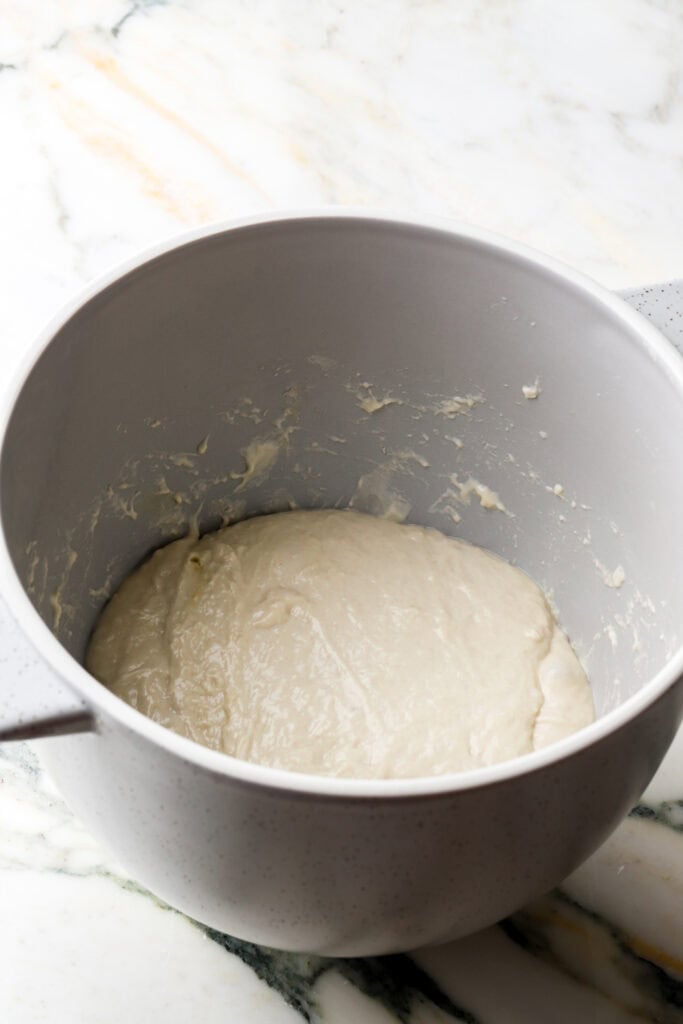


Kneading the dough
I don’t knead this dough. I mix it just until it’s all combined. The dough gets really sticky so let it rest for about an hour. Then you’ll perform two series of stretches and folds to strengthen the gluten and then just let it rest overnight.
Stretch and Folds
If you’re at all familiar with sourdough, you’ll likely know what this is lol. But basically instead of kneading, we will stretch the dough out and fold it over itself to develop the gluten. The stretching will help the gluten build strength to give it structure so you get a nice big oven spring.
You’ll start by just grabbing one side of the dough, stretch it out as far as it goes without tearing and then fold it over top of the rest of the dough. Do that four times, turning the bowl 90 degrees each time so every side of the dough is stretched. See the video above for a better reference.
Let it rest for 30-60 minutes and then repeat this again.
Since the dough is quite sticky at this point, run your hands under cold water between every stretch. This will prevent the dough from sticking to your hand as much.
What temperature to proof dough at?
You want to make sure your dough is proofing at a comfortable temperature. I prefer room temperature because it’s been rising for so long, so try to keep it somewhere around 75F (24C).
The dough can also be proofed in the refrigerator. This is called a retarding proof because it really slows down the process. The benefit of this is that you can just pop the dough in the fridge for a longer period of time and the dough will develop a stronger flavor if it rises for longer. I would do at least 18 hours, and up to 72 hours, if you’re going to refrigerate it overnight though.
You can refrigerate the dough overnight for the first proof but then shape it and bring it back to room temperature before baking.
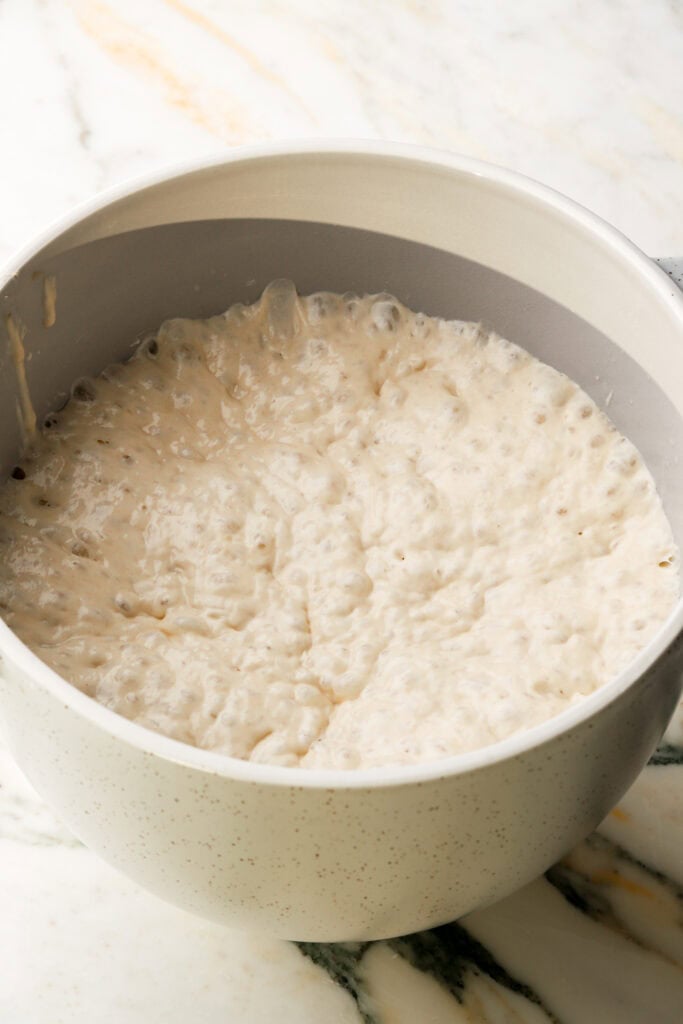
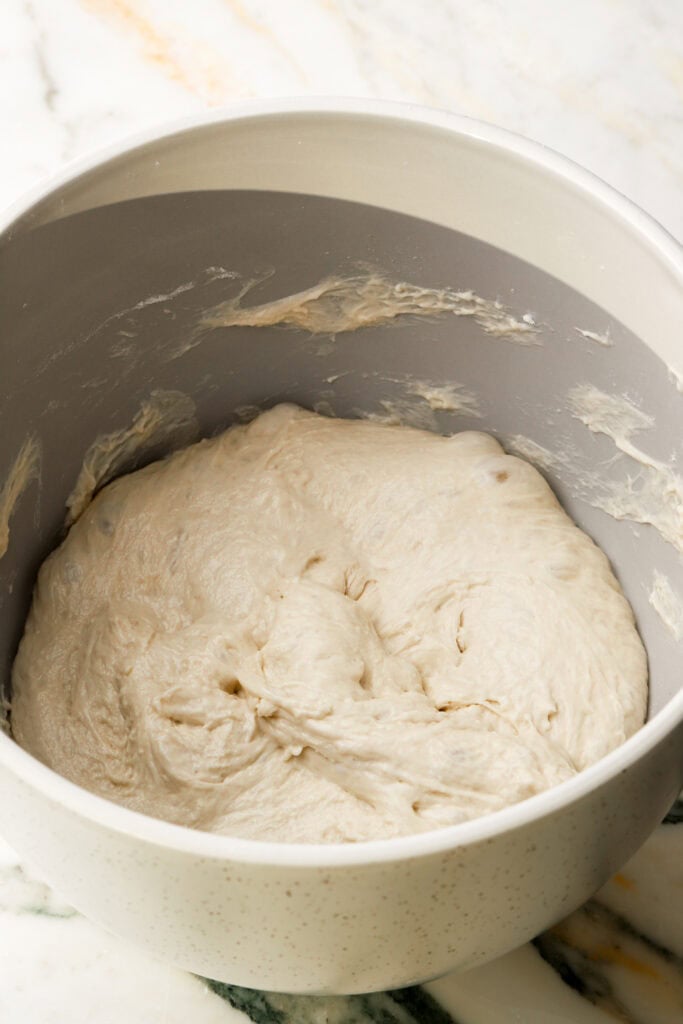
Rising and Proofing the dough
Rising and proofing are typically used interchangeably but the initial ‘resting time’ is actually the ‘rising’ and the second ‘resting time’ is the ‘proofing’. The time needed for rising/proofing is dependent on the recipe and the environment.
Typically with instant yeast, a lot of recipes allow you to skip the first rise and just let the dough relax for just 10-30 minutes instead, before shaping the dough. For this bread, you will need to let it rise and proof fully. The initial overnight rise is what builds structure and flavor so don’t skip it.
A general guideline for proofing and rising is that the dough should double in size each time. It should also slowly spring back when you press on it, but also leave a small indent. This is not the case here. The initial overnight rise will cause the dough to get really loose and bubbly and jiggly, there’s no poking and springing back happening here lol.
But for the second proof, that is kind of what you’re looking for, however it won’t exactly double in size.
Before going into the oven, the dough should be tight enough to slowly spring back when you press on it. If it springs back quickly, then it needs more time to rise. If it doesn’t spring back at all and is quite flimsy, it is likely over-proofed and may result in a flat, deflated bread or just lack a good oven spring.



How to shape Italian bread
Again, she’s a sticky dough so when handling, you’ll want to use flour on the work surface and your hands.
After it rises overnight, the dough will still be loose, however the gluten will have developed enough to hold itself together. You may get a little sticking to your fingers so flour your hands as well but overall, it should be able to be handled if you work quickly.
Dump the dough onto a floured surface. Flour your hands and dust some more flour onto the dough. Lightly stretch it out into a rectangle. No need to roll it out thin or stretch it far, just try to get a rectangle going like in the photos. Then fold the top ⅓ down and then the bottom ⅓ on top of the top ⅓, like a letter that goes into an envelope.
Then start at a short end and roll it up. You’ll have the layers on the side exposed so you’ll try to roll the ball of dough back and forth a little to close up the exposed layers. Watch the video above because it’s hard to explain lol.



How to bake Italian bread
My oven runs super hot on the bottom so besides pie, I pretty much bake everything on convection (which means the fan is circulating the heat around). I bake this bread at 450F (232C) in a dutch oven, for about 15 minutes with the lid on and then another 20ish minutes with the lid off. Most home ovens will adjust your temperature to 425F if you preheat it to 450F convection but my oven thermometer is reading 450F when I set it to 450F convection so make sure to get an oven thermometer for best results.
The internal temp should be at least 195F (90C) but mine is usually around 200F (93C).
Don’t go based on the color on the top because it can be done quicker before it darkens in color. I like the darker color so sometimes I leave it in there just a smidge longer or take the lid off sooner. Also don’t bother sticking a knife in there cuz that won’t do anything with dough.
If it’s fully baked, the bread should feel light when you pick it up though.
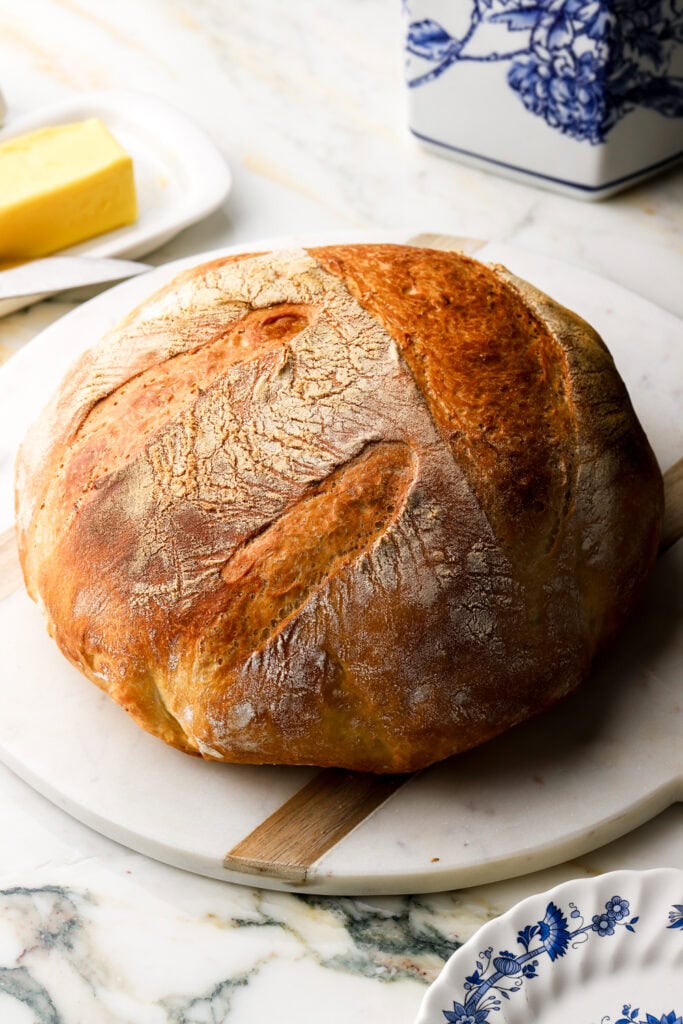
How to serve Italian bread
My personal favorite way to eat any bread is warm with European butter and flakey sea salt. I could literally live off that alone.
I’ve also used this bread to make the absolute best sandwiches and I love it for avocado toast! It’s also great for soaking up things like dips, egg yolks or soups.
But if you just want to rub some garlic on it and serve it with olive oil and seasoning, she’s perf.
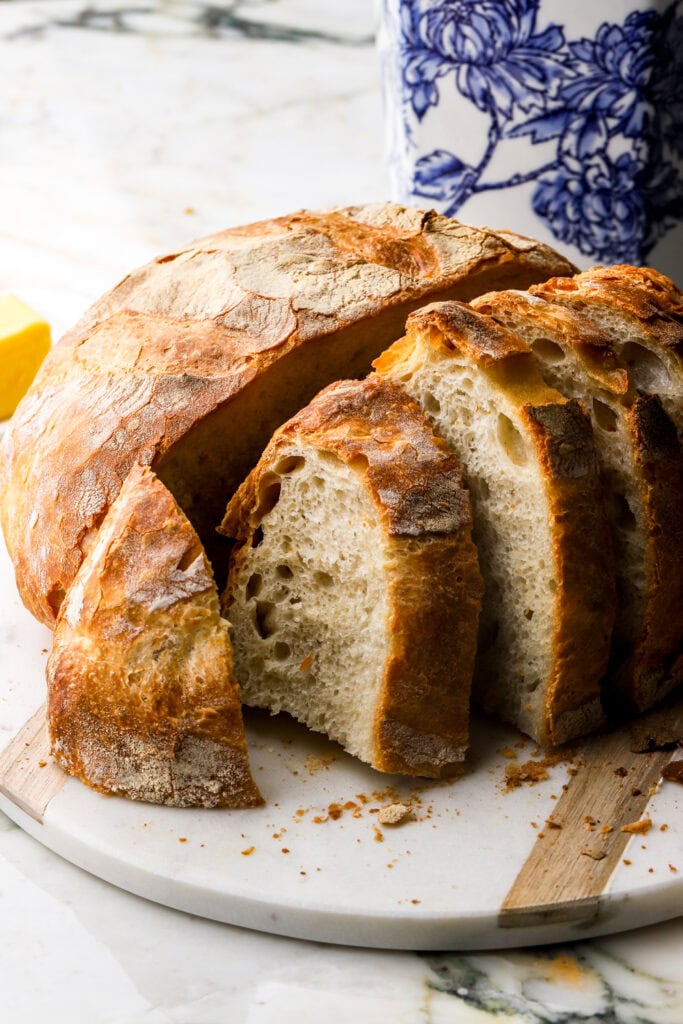
How to slice bread
Although warm bread is sooooo delicious, it’s important to let your bread cool completely before slicing. This will make the bread the fluffiest it can be. If you slice it warm, it can become a little gummy.
Once it’s cooled, slice the bread in half. Then place the open side face down on the board and slice through the crust. Doing it this way will make it easier not to squish the bread as you’re slicing it.
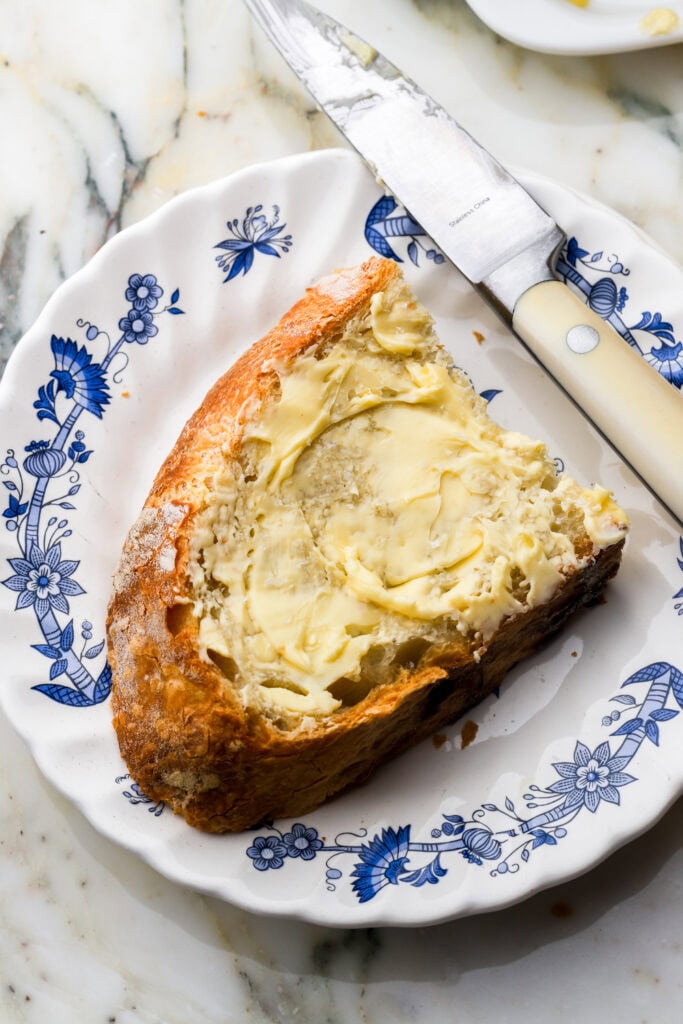
How to store Italian bread
Obviously bread is always best fresh cuz there’s nothing like a warm slice of bread. However, this bread does keep really well! I leave it on the counter in a ziplock bag for 4-5 days and if it hasn’t gotten eaten by then, I refrigerate it for up to a week or freeze it for longer.
If it’s from the fridge I usually microwave it for 10 seconds for the kids or toast it for myself. If it dries out at all, just toast it and spread some butter or avocados on top and it’s good to go.

If you’ve made it this far, I apologize for the length but I hope this post is helpful to make the best crusty Italian bread at home!
If you make it, I’d love it if you left me a review or a star rating and as always, have a blessed day and happy baking!
Love, B

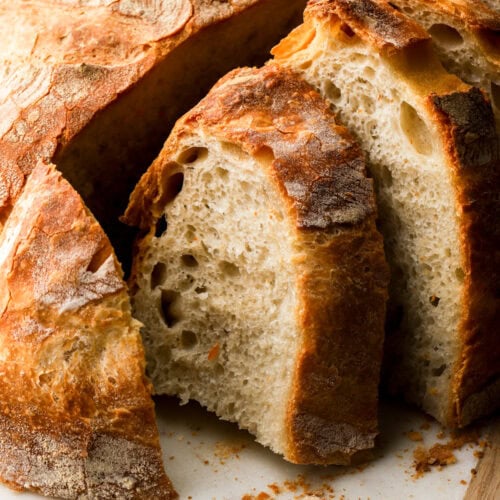
I love this bread it’s my favorite! I was wondering if after the final rise in the morning if you could cut it into smaller balls to make rolls and how long it’d bake for.
Hi Jessica, thank you so much I’m so glad you like the recipe!
I haven’t tried that but there’s no reason it wouldn’t work. If you’re referring to dinner rolls, they usually have a little added fat to them to make them softer.
Thank you for sharing this recipe! I baked my first italian bread, and came out so good!
OMG! That pretty much says it all. I’ll be doing this again tomorrow…because the first loaf will be gone in about 10 more minutes. So easy! So good!
Oh thank you so much, so happy you like it!:)
Can I use a cast iron pot that is 10 inches in diameter and 3 inches high
not including the lid
You could, if the lid doesn’t fit, you could just bake it without a lid and if it gets too brown, cover with foil for part of the time
There will be less steam so you may end up with a slightly wider and shorter loaf
Hi Jessica, try just 3-4 ice cubes and remove the lid sooner and that should give it more time to brown.
My dough wasn’t sticky like in your video. Will it still work?
Hi Crystal, I can’t really say without seeing it but I would still try baking it and see how it turns out! I would assume it would be a little more dry but still good to eat.
You let room temp rise for 8 hours then overnight in fridge.? (Another 8 hours in fridge?). Sounds good to me- just making sure I’m following- thanks!
Followed directions to the letter – perfection! Used a mixture of bread flour and all-purpose flour. Was thinking of making again with an egg wash and sesame seeds – what do you think?
Many thanks for this – I am a fan!
It should work just fine! Glad you liked the recipe 🙂
Best recipe!! I have tried many 👍
Fabulous. So much better than the un-enriched doughs I’ve been making in a similar way. I used olive oil and let it rise room temp for about 8 hours then put it in the refrigerator. I let it rest for 30 minutes in the morning then shaped and baked. Thank you thank you!
You let room temp rise for 8 hours then overnight in fridge.? (Another 8 hours in fridge?). Sounds good to me- just making sure I’m following- thanks!
Don’t you need to dissolve the active dry yeast in
warm water before it gets mixed into dough? Or is that initial step not needed in this recipe?
That is only necessary to “prove” your yeast is still active. If you know your yeast is good, that step is completely unnecessary. People only do it because it would be a shame to put in all that time and effort, only to discover their yeast is dead.
Hello. Trying to find the video for the bread recipe. Where is it? Thank you. B.
Hi, the video is towards the top of the post, slightly under the table of contents
This is a beautiful recipe. I followed it exactly, appreciating the weight measurements as the way to go, which are more exact, and it turned out a light, airy, crispy, chewy loaf. Just exceptional.
Thank you Robert, I’m so glad you liked it! 🙂